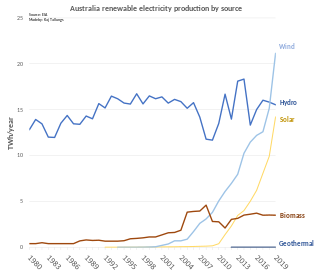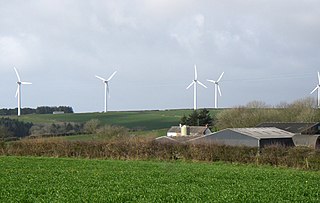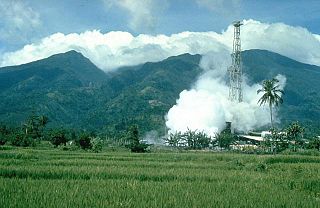
Geothermal energy is the thermal energy in the Earth's crust which originates from the formation of the planet and from radioactive decay of materials. The high temperature and pressure in Earth's interior cause some rock to melt and solid mantle to behave plastically. This results in parts of the mantle convecting upward since it is lighter than the surrounding rock. Temperatures at the core–mantle boundary can reach over 4000 °C (7200 °F).

The National Power Corporation is a Philippine government-owned and controlled corporation that is mandated to provide electricity to all rural areas of the Philippines by 2025,to manage water resources for power generation,and to optimize the use of other power generating assets.

Renewable energy in Australia includes wind power,hydroelectricity,solar photovoltaics,heat pumps,geothermal,wave and solar thermal energy.

Renewable energy commercialization involves the deployment of three generations of renewable energy technologies dating back more than 100 years. First-generation technologies,which are already mature and economically competitive,include biomass,hydroelectricity,geothermal power and heat. Second-generation technologies are market-ready and are being deployed at the present time;they include solar heating,photovoltaics,wind power,solar thermal power stations,and modern forms of bioenergy. Third-generation technologies require continued R&D efforts in order to make large contributions on a global scale and include advanced biomass gasification,hot-dry-rock geothermal power,and ocean energy. As of 2012,renewable energy accounts for about half of new nameplate electrical capacity installed and costs are continuing to fall.
For solar power,South Asia has the ideal combination of both high solar insolation and a high density of potential customers.

According to preliminary data from the US Energy Information Administration,renewable energy accounted for about 12.6% of total primary energy consumption and about 19.8% of the domestically produced electricity in the United States in 2020.

Renewable energy in the United Kingdom contributes to production for electricity,heat,and transport.

Geothermal power is electrical power generated from geothermal energy. Technologies in use include dry steam power stations,flash steam power stations and binary cycle power stations. Geothermal electricity generation is currently used in 26 countries,while geothermal heating is in use in 70 countries.

The utility electricity sector in Bangladesh has one national grid with an installed capacity of 25,700 MW as of June 2022. Bangladesh's energy sector is not up to the mark. However,per capita energy consumption in Bangladesh is considered higher than the production. Electricity was introduced to the country on 7th of December,1901 under British rule.

Geothermal power in Indonesia is an increasingly significant source of renewable energy. As a result of its volcanic geology,it is often reported that Indonesia has 40% of the world's potential geothermal resources,estimated at 28,000 megawatts (MW).

Wind power in the Philippines accounts for a total of 443MW as of 2020 according to the Department of Energy,covering about 1.6% of the country's total installed capacity for both renewable and non-renewable energy sources. When it comes to existing renewable energy sources in the country,wind power has a total share of approximately 5.4%. Despite currently being a small contributor to the country's energy mix,wind power installations have increased from 33MW in 2012-2013 to 337MW in 2014,427MW in 2015-2018,and 443MW in 2019-2021. Moreover,the Department of Energy's National Renewable Energy Plan (NREP) 2020-2040 aims to commission 2,345MW of total wind power capacity by 2030. There has been a setback,however,as the wind power industry was moderately affected by COVID,particularly in the import of wind turbines. Due to this,several projects such as the Aklan onshore wind project got delayed. To further drive the wind energy sector in the country,an increased demand for renewable energy,greater government commitments,and reduced wind power tariff are needed.
The Wind Energy Power System (WEPS) is a wind farm project located near Puerto Galera,in the Philippine province of Mindoro Oriental. Once completed the project will generate an estimated 48MW of electricity.

Renewable energy in Mexico contributes to 26 percent of electricity generation in Mexico. As of 2009,electricity generation from renewable energy comes from biomass,hydro power,geothermal,solar power and wind. There is a long term effort established to increase the use of renewable energy sources. The amount of geothermal energy used and harvested,places Mexico as number four in the world.

The electricity sector in the Philippines provides electricity through power generation,transmission,and distribution to many parts of the Philippines. The Philippines is divided into three electrical grids,one each for Luzon,the Visayas and Mindanao. As of June 2016,the total installed capacity in the Philippines was 20,055 megawatts (MW),of which 14,348 MW was on the Luzon grid. As of June,2016,the all-time peak demand on Luzon was 9,726 MW at 2:00 P.M. on May 2,2016;on Visayas was 1,878 MW at 2:00 P.M. on May 11,2016;and on Mindanao was 1,593 MW at 1:35 P.M. on June 8,2016. However,about 12% of Filipinos have no access to electricity. The Philippines is also one of the countries in the world that has a fully functioning electricity market since 2006 called the Philippine Wholesale Electricity Spot Market(WESM) and is operated by an independent market operator.
In 2013,renewable energy provided 26.44% of the total electricity in the Philippines and 19,903 gigawatt-hours (GWh) of electrical energy out of a total demand of 75,266 gigawatt-hours. The Philippines is a net importer of fossil fuels. For the sake of energy security,there is momentum to develop renewable energy sources. The types available include hydropower,geothermal power,wind power,solar power and biomass power. The government of the Philippines has legislated a number of policies in order to increase the use of renewable energy by the country.

Vicente Gonzales Duterte,also known by his nicknames Nene and Teti,was a Filipino politician and lawyer. He became Governor of the then-unified province of Davao,succeeding Alejandro Almendras who was elected Senator.

Renewable energy in South Africa is energy generated in South Africa from renewable resources,those that naturally replenish themselves—such as sunlight,wind,tides,waves,rain,biomass,and geothermal heat. Renewable energy focuses on four core areas:electricity generation,air and water heating/cooling,transportation,and rural energy services. The energy sector in South Africa is an important component of global energy regimes due to the country's innovation and advances in renewable energy. South Africa's greenhouse gas (GHG) emissions is ranked as moderate and its per capita emission rate is higher than the global average. Energy demand within the country is expected to rise steadily and double by 2025.

Agnes Almendras Magpale is Filipina educator and politician from Cebu,Philippines. In 2010,she became a Cebu Provincial Board Member,acting Vice Governor,and acting Governor within a single three-year electoral term through succession. She assumed the Vice Governor post upon the death of incumbent Gregorio Sanchez,Jr. in 2010 and became acting Governor when Gwendolyn Garcia was suspended in 2012.
ACEN Corporation,formerly AC Energy,is the energy firm under the Ayala Group. The company has over 4,000 MW of attributable capacity in the Philippines,Vietnam,Indonesia,India,and Australia,with a renewable share of 98%,which is among the highest in the region.

The Tiwi Geothermal Power Plant is a 234-MW geothermal power station in Tiwi,Albay,Philippines.


















